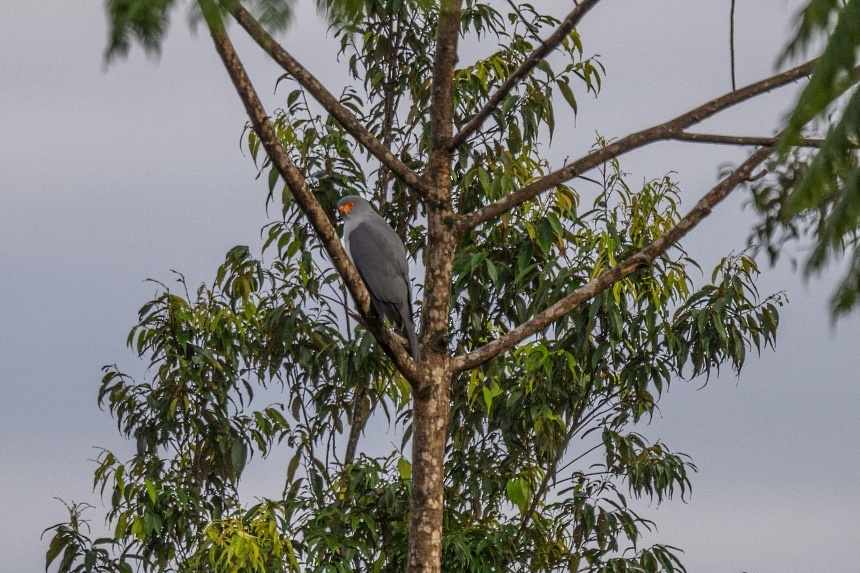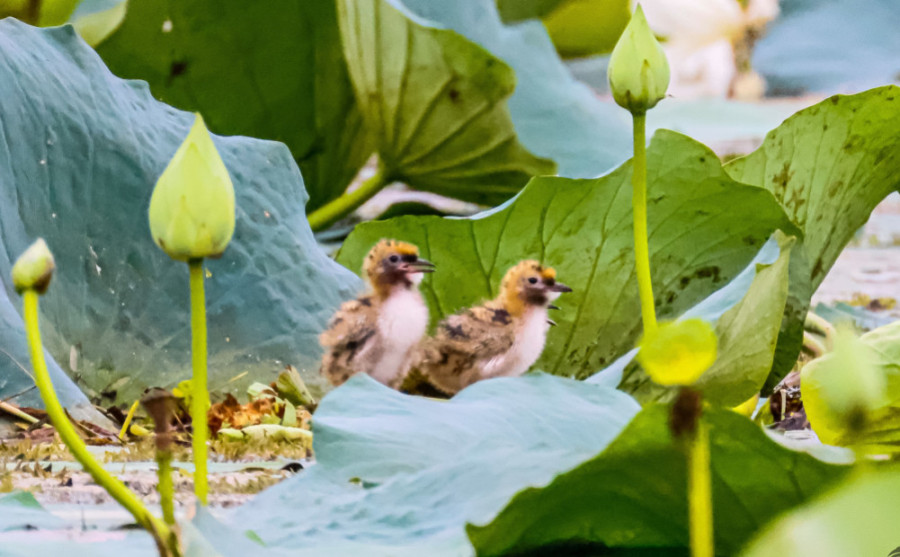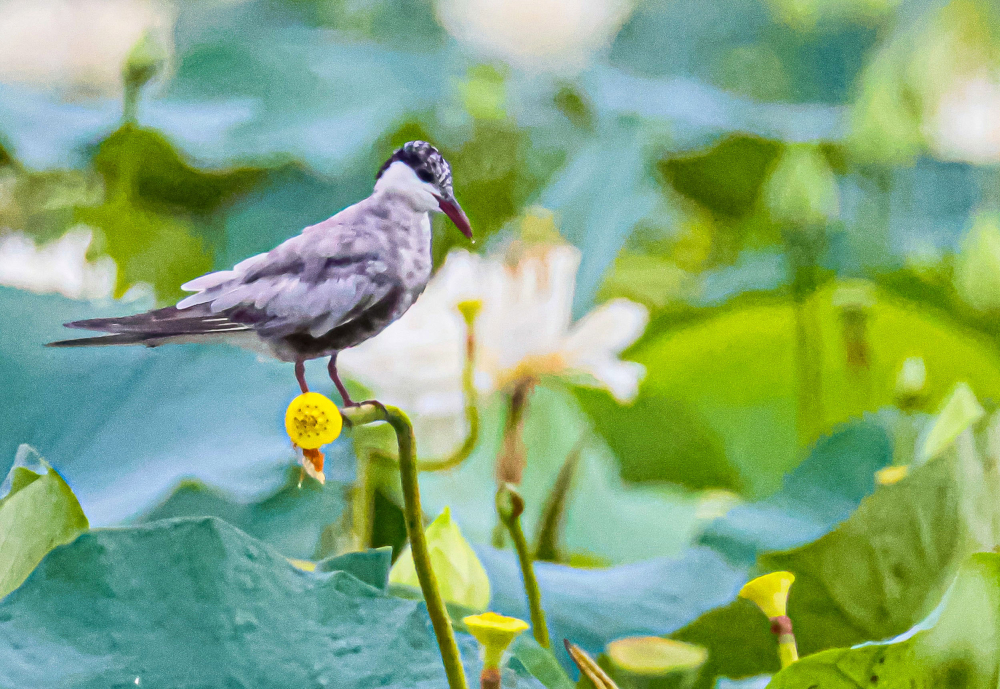
Sep 13, 2024,
BANGKOK – A hawk-eyed photographer has thrilled scientists by snapping a photo of a threatened bird of prey in Papua New Guinea, more than five decades since it was last officially documented, the World Wildlife Fund (WWF) said Sept 13.
The New Britain goshawk is found on only Papua New Guinea’s New Britain island and is considered threatened, though information about its status is sparse.
The International Union for the Conservation of Nature estimates there are between 2,500 and 10,000 mature individuals in the wild, but the bird’s elusive nature makes details hard to confirm.
In fact, the bird is so unusual that Fiji-based photographer Tom Vierus did not even realise what he captured until later.
“It was such a great surprise to hear that this photo seems to be the first-ever of this ‘lost species’,” he said in a statement issued by WWF, an environmental non-governmental organisation.
The last scientific documentation of the species appears to be a 1969 specimen now kept in a US museum, according to Mr John Mittermeier, director of the Search for Lost Birds at the American Bird Conservancy.
While there have been sporadic reported sightings, “the New Britain goshawk seems to have eluded photo, sound, and specimen documentation for 55 years”, he said.
WWF said the discovery highlighted the importance of protecting the area from threats including logging and mining.
Much of Papua New Guinea’s population lives below the poverty line, and many officials are keen to welcome companies to exploit vast reserves of gold, copper, nickel, natural gas and timber.
It is also home to the world’s third-largest intact tropical forest, according to WWF, and environmentalists warn little research has been done on the diverse and rich ecosystems now at risk.

Manoj Paudel
Published at : September 15, 2024
Kapilvastu
Whiskered tern, locally known as ‘Thimaha Fyalfyale,’ has propagated in Nepal, reportedly for the first time. The bird was spotted nesting at Jagadishpur Lake Bird Reserve in Kapilvastu, where it has hatched chicks.
Dr SK Singh from Janakpur captured the photographs of five chicks from two nests located at the northeastern edge of a mound in the middle of the reserve. “While boating, a whiskered tern nearly pecked at my head,” said Singh, who is a physician by profession and has recently developed a passion for wildlife photography. “Proceeding with caution, I noticed two nests with chicks.”
He managed to photograph three chicks in one nest and two in the other before retreating to avoid disturbing them. Anil Chaudhary, a nature guide accompanying him, observed 60-70 whiskered terns flying and resting in the area. He estimated that there were at least 15-20 nests.
The whiskered terns are typically found near seas, rivers, and wetlands across Europe, Asia, Africa, and Australia. Senior ornithologist Hemsagar Baral confirmed that this is the first recorded instance of the species breeding in Nepal. “It’s good news for the country,” he said. “This will attract more attention to eco-tourism.”
Last year, in the last week of August, wildlife photographers Sugam Tamrakar and Pemba Sherpa spotted whiskered tern nests at Jagadishpur Lake, while Nishan Baral discovered nests near Koshi Bridge. However, once the news broke, an influx of photographers at Jagadishpur caused the birds to abandon their nests. Unfortunately, Baral was unable to follow up on the nesting activities at Koshi.
This year, the successful breeding of black-winged stilts at Jagadishpur has added another attraction to the site. “We are delighted,” said Deepak Bahadur Gurung, the chairman of ward 9 in Kapilvastu Municipality. He noted that stricter measures have been implemented this year to prevent disturbance to the birds inside the lake, ensuring they can rear their chicks undisturbed.
Singh, who originally came to photograph pheasant-tailed jacanas, locally known as jal apsara, expressed his joy at setting a new record for the country by photographing the whiskered tern chicks.

The whiskered terns are irregular winter visitors to Nepal and a migratory species during spring. Although there hasn’t been specific research on where the birds migrate from, ornithologists speculate that they may come from around the Arabian Sea.
While common in other countries, it is a rare migratory visitor to Nepal. This bird is notoriously difficult to photograph, except during nesting season, due to its highly restless nature, ornithologists say.
The whiskered tern builds its nests using aquatic plants and twigs on the water. Of the eight tern species, this one primarily feeds on insects and small invertebrates. In the breeding season, it is distinguishable by its white face, black head, and light-coloured lower body.
In 1982, more than 400 whiskered terns were recorded at Koshi Barrage. Forty-one years later, nearly 100 were spotted at Jagadishpur last year, according to ornithologist Hathan Chaudhary. He suggested that the impacts of climate change and rising sea temperatures may have prompted these birds to select Nepal’s wetlands as a safer breeding ground.
Jagadishpur lake, which was listed as a Ramsar wetland site in 2003, was declared a bird sanctuary, the country’s second, in July 2022. The lake is spread over an area of 157 hectares across Kapilvastu Municipality’s wards 9 and 10, and is located some 11 kilometres north of Taulihawa, the district headquarters of Kapilvastu.
The lake has become a favoured spot for nesting birds due to its rich biodiversity, said ornithologist Krishna Prasad Bhusal. “The lake’s environment is currently very bird-friendly, attracting various species to nest and rear their young.”
Whiskered terns typically lay eggs in July-August, with chicks hatching by August-September. They rear their young for two to three months before migrating back to their summer grounds.
The lake, often considered a birdwatcher’s paradise, provides a sanctuary for waterfowl in Nepal. According to an IUCN Nepal study, the lake is home to 43 species of fish, 10 species of amphibians, 42 species of reptiles, and 32 species of mammals.
Moreover, as many as 167 bird species have been recorded in the area, including 92 resident species, nine that visit during the summer, 64 winter visitors, and three partial migrants. The lake also hosts globally endangered species such as the fishing cat and eight other rare bird species.

Manoj Paudel is the Kapilvastu correspondent for Kantipur Publications.
Pair of taxidermied huia could fetch $128k at London auction

A pair of huia being auctioned by Roseberys in London. Photo: Supplied / Roseberys
A pair of taxidermied huia are expected to fetch up to NZ$128,000 when they are auctioned in London in October.
The birds - a male and a female - date to the late 1800s, auctioneer Roseberys said.
"Specimens of these striking songbirds are rarely seen on the market and displays showcasing both a male and female bird are even harder to come by."
Huia were once widespread throughout the North Island, but populations declined swiftly following human settlement and the last confirmed sighting was in 1907.
The birds had a special place in Māori culture, with their highly prized tail feathers often being worn to denote status.

Male huia, pictured, had shorter, straighter beaks than the females. Photo: Supplied / Roseberys
In May, a single huia feather sold for $46,521 at auction in Auckland, breaking the record for the most expensive feather ever sold at auction.
Roseberys described the taxidermied pair as being "eye-catching" examples of huia, with "deep metallic, bluish-black plumage, orange wattles and long white-tipped tail feathers ... in very good condition".
The auction was "a rare opportunity to acquire a fine example of an extinct species", the auctioneers said.
The birds are expected to go for between £40,000 and £60,000 (NZ$85,000-$128,000). Bidding starts at £28,000 (NZ$60,000).
Being auctioned in the same lot are a Louis Vuitton monogrammed canvas wardrobe trunk from the 1920s, and a piece of fruit cake from the 1947 wedding reception of Queen Elizabeth II and Prince Philip.
No comments:
Post a Comment